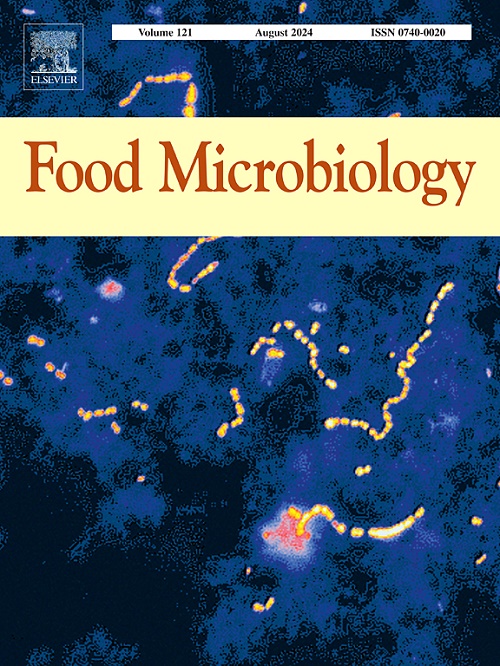l型苯乳酸盐在“三鸟一石”防治黑木耳中角兰伯克氏菌生长及产酸的新应用
IF 4.5
1区 农林科学
Q1 BIOTECHNOLOGY & APPLIED MICROBIOLOGY
引用次数: 0
摘要
剑兰伯克霍尔德菌是一种食源性病原体,以其产生有毒代谢物苯丙酸(BA)而闻名。本研究旨在探讨l型苯乳酸酯(L-PLA)在“三鸟一石”控制剑兰生长、生物膜形成和BA生成中的新应用。L-PLA对剑兰的最小抑菌浓度和最小杀菌浓度均为2.0 mg/mL。L-PLA破坏了剑兰的完整性和结构,导致细胞内成分渗漏,降低细胞活力。同时,活性氧的积累表明,氧化应激参与了解离剑兰的杀菌机制。扫描电镜(SEM)和共聚焦激光扫描显微镜(CLSM)结果证实了L-PLA对剑兰的严重破坏。此外,亚抑制浓度的L-PLA可以有效地抑制生物膜的形成,这是通过减少生物膜生物量和降低生物膜内活菌和死菌的比例来实现的。L-PLA对剑兰细胞的运动有明显的抑制作用,并伴有细胞表面疏水性和自聚集性的改变。此外,L-PLA胁迫5 d后,BA的合成明显减少。RT-qPCR结果显示,L-PLA抑制了BA生物合成相关基因的表达。L-PLA (1/2 × 2 × MIC)显著抑制了黑木耳浸泡液中剑兰B.的细菌存活率和BA产量,且不影响感官可接受性。因此,本研究证明了L-PLA作为一种强大的剑兰生长和BA生物合成抑制剂的功效,有助于管理和预防食物中的剑兰。本文章由计算机程序翻译,如有差异,请以英文原文为准。
Novel application of L-type phenyllactate in the “three birds one stone” control of Burkholderia gladioli growth and bongkrekic acid production in Auricularia auricula
Burkholderia gladioli is a foodborne pathogen known for its production of toxic metabolites bongkrekic acid (BA). The aim of this study was to investigate a novel application of L-type phenyllactate (L-PLA) in the “three birds one stone” control of B. gladioli growth, biofilm formation, and BA production. The minimum inhibitory concentration and minimum bactericidal concentration of L-PLA against B. gladioli were both 2.0 mg/mL. L-PLA disrupted the integrity and structure of B. gladioli, resulting in leakage of intracellular components and reduction of cell viability. Meanwhile, the accumulation of reactive oxygen species indicated that oxidative stress was involved in the bactericidal mechanism of dissociated B. gladioli. SEM and confocal laser scanning microscope (CLSM) results confirmed the severe destruction of B. gladioli by L-PLA. Additionally, subinhibitory concentrations of L-PLA could effectively inhibit biofilm formation, which was achieved by a decrease in biofilm biomass and a reduction in the proportion of live and dead bacteria within the biofilm. L-PLA demonstrated a notable inhibitory effect on the motility of B. gladioli, accompanied by alterations in cell surface hydrophobicity and auto-aggregation. Furthermore, the synthesis of BA was considerably decreased when exposed to L-PLA stress for 5 d. RT-qPCR showed that the expression of genes involved in BA biosynthesis was suppressed by L-PLA. Notably, bacterial survival rate and BA production of B. gladioli in the Auricularia auricula soaking solution was significantly inhibited with L-PLA (1/2 × -2 × MIC), and did not affect sensory acceptability. Therefore, the present study demonstrates the efficacy of L-PLA as a powerful suppressor of both growth and BA biosynthesis in B. gladioli, aiding in the management and prevention of B. gladioli in food.
求助全文
通过发布文献求助,成功后即可免费获取论文全文。
去求助
来源期刊

Food microbiology
工程技术-生物工程与应用微生物
CiteScore
11.30
自引率
3.80%
发文量
179
审稿时长
44 days
期刊介绍:
Food Microbiology publishes original research articles, short communications, review papers, letters, news items and book reviews dealing with all aspects of the microbiology of foods. The editors aim to publish manuscripts of the highest quality which are both relevant and applicable to the broad field covered by the journal. Studies must be novel, have a clear connection to food microbiology, and be of general interest to the international community of food microbiologists. The editors make every effort to ensure rapid and fair reviews, resulting in timely publication of accepted manuscripts.
 求助内容:
求助内容: 应助结果提醒方式:
应助结果提醒方式:


